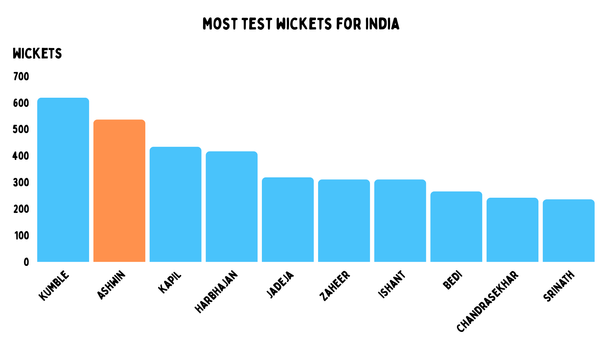India and the boys who bat
It's not as simple as just two cricket teams. These are people on the field.

Rural Uttar Pradesh, 2012.
A 10-year-old with cricket in his veins embarks on a miraculous and dangerous journey of a thousand miles from his village to one of the world's biggest cities, Mumbai. Initially he lives with his uncle in the northern suburb of Dadar, but sadly, that doesn’t last. Mumbai's intense daily commute consumes precious hours, prompting the boy find refuge in a dairy shop, exchanging his labour for a place to rest his head. However, that goes away as well. The only thing that stuck around was the passion for cricket.
His parents beg for him to come home. But instead, he went to the Azad Maidan, where he takes residence in the Muslim United club ground staff tent. More than almost any player before him, this boy found a home in cricket.
In this Test match, that boy, Yashasvi Jaiswal, made 209 runs in the first innings, more than half India’s total. He was the boy who batted.
The problem for Indian cricket is that two things are true simultaneously, and they couldn’t be further removed from each other. We have never had a cricket team with as much power, money and impact as the Indian team since England in the 1800s. India are Amazon, and the other boards are selling second-hand books on the weekend at a local stall.
Every decision made in our game is made with India in mind, or the shadow they cast.
Then there are the stars, Virat Kohli has 60 million Twitter followers, which is a ratio of about 30 million people to every non-sponsored tweet. Rohit Sharma has a huge army of supporters, that he barely seems to notice as he just goes about enjoying his life. And R Ashwin is trying to make nerds cool again. We know their partners, their childhood friends and random overly personal stories about them.
But even players like this had to start somewhere. And the origin stories of Indian players continue to be amazing. We can be romantic about it, but how about the maths? In 2010 there were more than 50 million men aged 25-29 inside India. That is about how many people in total live in England or South Africa. And that is just men in their peak athletic years. At any stage, you could argue an Indian player is one in a ten-million chance.
But what about their stories? Jaiswal is an extreme example, so let’s look at Mukesh Kumar.
He is from a farm in Bihar. A small town job a long way for the many pulsating Indian metropolises He was on his way to being a police officer, but somehow failed on fitness grounds. So he thought he might as well take cricket more seriously.
The issue was that Bihar is not a hotbed of our sport, so without any premier domestic cricket to play, he made his money as a bowler for hire in tape ball games. It was only after his father dragged him to Kolkata that things started to change for him. And do you know what he wants to do when he finishes cricket? Not become an underwear model or celebrity gameshow contestant, but go back to his village and farm.
Rajat Patidar is a late bloomer. He was a fast bowler who tore the ACL in his knee. So he took to off-spin; that wasn’t worth it either. So he picked up the bat. His first year in the IPL was 2021. By then, he was almost 30. And he failed. He wasn’t picked up for the 2022 season. He was preparing to be married and wasn't sure sitting on an IPL bench was worth changing his wedding for. But he was convinced to pick the IPL, and that year he averaged 50, making 333 runs at a huge strike rate.
He should have been on the rise, but the next year injured his foot and missed the following season. His career is full of half-starts and injuries, but now, with his wedding behind him and other people getting hurt, he gets his chance. Rajat Patidar thought he was going to bowl for India, instead he batted at five.
Axar Patel is spelled that way because his high school principal made a mistake on one of his forms. But why would that matter? Well, because when he was chosen to play for India Under 19s, a series of incidents from a sitcom occurred because he didn’t even have a passport. In one moment his life, and name, were changed.
The first year Shreyas Iyer turned up at Pravin Amre’s camp, it was already full and he was sent away. That has been Iyer’s career, missing out on chances. He probably should have played more ODI cricket and even taken over a spot for the 2019 World Cup. A chance in Test cricket could have come even three years earlier.
KS Bharat started as a ball boy in Vizag. Since the former Indian captain Vizzy stopped playing, Vizag has not exactly been a hotbed of cricket decision-making. But Bharat got a taste of what his life could be when he was a ball boy on the boundary for an MS Dhoni hundred.
But this specialist keeper didn’t even take up the gloves until he was 19. And then he had to wait for Dhoni, outshine Dinesh Karthik shirts, Wriddihman Saha’s great hands and be available after Rishabh Pant's freak injury. It means that KS Bharat was often the fifth choice on the depth charts in his position, despite playing for India A. How this ball boy got to a position behind the stumps from there is pretty remarkable.
Kuldeep Yadav was a player who was thrust through the system in part because he bowled the right kind of bowling with the wrong arm. He was a freakshow performer, and then it all started to go away, as often happens with left-arm wrist spin. Well, he only went and made himself a better bowler than in the days when no one could play him. That is a hell of a comeback.
But that all happened because he had already had to come back once. As a kid, he wanted to be Wasim Akram. The only problem is, he is not that kind of athlete. So he took up wrist spin, and here he is.
When India and England play each other, it is the one percenters of cricket. Their support staff have support staff. The money and opportunities available to these two sets of players is unlike almost the rest of cricket combined. This is the haves versus the haves, nots need not apply.
Years ago I wrote about how important it was to Sri Lanka to defeat India in the 2014 World Cup and people were upset. These were just two cricket teams, one beat the other, simple as that. But it’s not, the history of nations plays a part. But so does simple humanity. These are people on this field.
India have an inexperienced side, Bazball is playing with their minds, and they held on as England came for them.
Sometimes we get lost in the cricket and forget about the people when we talk about the players themselves. Jimmy Anderson is a club bowler who got fast, Rehan Ahmed is a cricket nerd plucked from nowhere, and Jack Leach has been battling his body his entire life.
India won this Test on the back of Jasprit Bumrah’s incredible bowling and two great batting performances. One by Shubman Gill. Who is now a man, but even so, his father still complains when he only gets a hundred in an ODI, and not a double.
And then there is Yashasvi Jaiswal. I know 30-year-olds who don’t know what they want to do with their life. I know 15-year-olds I wouldn’t trust to get the groceries from the local shop. At 10, he crossed his country to make his dream come true.
Thinking of all the things that could have gone wrong - and probably have - to others making similar journeys is heartbreaking.
Instead Jaiswal ran into a mentor who saw something of himself, and trained him up. But he also gave him a home and meals. There, Jaiswal climbed the incredibly competitive world of Mumbai cricket, which, for a kid with talent, a stable home and middle-class support, is tough. Yet at 17, he made his domestic debut. The Under 19s, IPL and Test stardom followed.
Jaiswal has only lived 22 years, two less than Sachin’s international career, yet he has also already lived a lifetime. In this Test, he went up against Anderson, who has spells longer than his career.
Jaiswal may have started as the boy who batted, but his innings in this Test was the man who won it.



